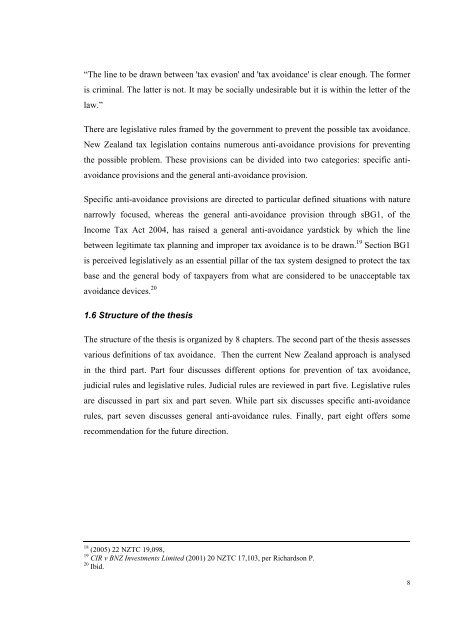Tax Avoidance: Causes and Solutions - Scholarly Commons Home
Tax Avoidance: Causes and Solutions - Scholarly Commons Home
Tax Avoidance: Causes and Solutions - Scholarly Commons Home
You also want an ePaper? Increase the reach of your titles
YUMPU automatically turns print PDFs into web optimized ePapers that Google loves.
“The line to be drawn between 'tax evasion' <strong>and</strong> 'tax avoidance' is clear enough. The former<br />
is criminal. The latter is not. It may be socially undesirable but it is within the letter of the<br />
law.”<br />
There are legislative rules framed by the government to prevent the possible tax avoidance.<br />
New Zeal<strong>and</strong> tax legislation contains numerous anti-avoidance provisions for preventing<br />
the possible problem. These provisions can be divided into two categories: specific antiavoidance<br />
provisions <strong>and</strong> the general anti-avoidance provision.<br />
Specific anti-avoidance provisions are directed to particular defined situations with nature<br />
narrowly focused, whereas the general anti-avoidance provision through sBG1, of the<br />
Income <strong>Tax</strong> Act 2004, has raised a general anti-avoidance yardstick by which the line<br />
between legitimate tax planning <strong>and</strong> improper tax avoidance is to be drawn. 19 Section BG1<br />
is perceived legislatively as an essential pillar of the tax system designed to protect the tax<br />
base <strong>and</strong> the general body of taxpayers from what are considered to be unacceptable tax<br />
avoidance devices. 20<br />
1.6 Structure of the thesis<br />
The structure of the thesis is organized by 8 chapters. The second part of the thesis assesses<br />
various definitions of tax avoidance. Then the current New Zeal<strong>and</strong> approach is analysed<br />
in the third part. Part four discusses different options for prevention of tax avoidance,<br />
judicial rules <strong>and</strong> legislative rules. Judicial rules are reviewed in part five. Legislative rules<br />
are discussed in part six <strong>and</strong> part seven. While part six discusses specific anti-avoidance<br />
rules, part seven discusses general anti-avoidance rules. Finally, part eight offers some<br />
recommendation for the future direction.<br />
18 (2005) 22 NZTC 19,098,<br />
19 CIR v BNZ Investments Limited (2001) 20 NZTC 17,103, per Richardson P.<br />
20 Ibid.<br />
8

















